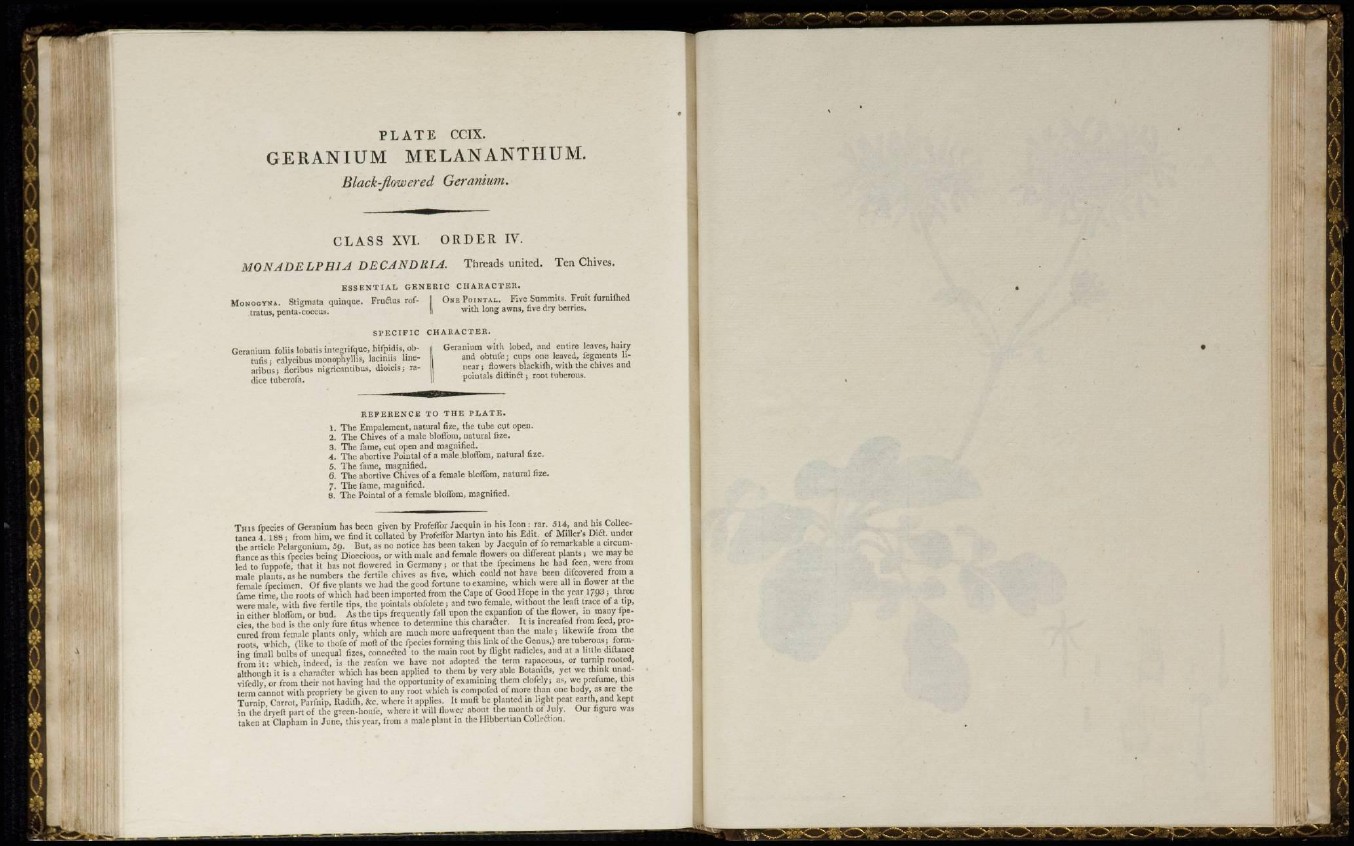
P L A T E CCIX.
G E R A N I U M M E L A N A N T H U M.
Black-flowered Geranium.
CLASS XVI. ORDER IV.
M O N A D E L P H I A D E C A N D R I A . Threads united. Ten Chives.
E S S E N T I A L G E N E R I C C H A R A C T E R.
M O N D G Y N * . Stigmata quinque. Frucius rof- II O N E P O I N T A L . Five Summits. Fruit furniihed
t r a t u s , penta-coccus. || with long a w n s , five d r y berries.
S P E C I F I C C H A R A C T E R.
G e r a n i um foliis lobatis integrifque, hifpidis, ob- Geranium witli lobed, and entire leaves, hairy
t u t i s ; calycibus monophyllis, laciniis line- and obtufe; cups one leaved, fegments lia
r i b u s ; floribus uigricantibus, d i o i c i s ; ra- near; flowers blackith, w i t h t h e chives and
dice tuberola. | poiutals diiu'iict; root tuberous.
R E F E R E N C E T O T H E P L A T E .
1. T h e Empalement, natural fize, the tube cut open.
2. The Chives of a male bloflbm, natural fize.
3. The fame, cut open and magnified.
4. T h e abortive Pointal of a male bloflbm, natural fize.
5. The fame, magnified.
G- T h e abortive Chives of a female bloflbm, natural fize.
J, T h e fame, magnified.
8 . The Pointal of a female bloflbm, magnified.
T H I S fpecies of G e r a n i um has been given by ProfelTor J a c q u i n in his I c o n : rar. 514, and his Collectanea
4. 1 8 8 ; from him, we find it collated by Profeflbr Martyn i n t o his Edit, of Miller's Diet, under
t h e a r t i c l e Pelargonium, 5g. Hut, as no notice has been taken by Jacquin of fo r e m a r k a b l e a circumfiance
as this fpecies b e i n g Dioecious, or w i t h male and female flowers on different p l a n t s ; we may be
led to fuppofe, that it has not flowered in G e r m a n y ; or that t h e fpeclmens he had feen, were from
male p l a n t s , a s h e numbers the fertile chives as five, which could not have been difcovercd from a
female lpecinien. Of five plants we had the good fortune to examine, which were all in flower at the
fame t i m e , t h e roots of which had been imported from the Cape of Good H o p e in t h e year l~g3 ; threewere
male, with rive fertile tips, t h : pointals obsolete; and two female, without the leaft trace of a tip,
in either bloflbm, or bud. As t h e tips frequently fall upon the cxpanfion of the flower, in many fp«-
cies, I h e b u d is t h e only litre fitus whence to d e t e r m i n e this character. It is increafed from feed, p r o cured
from female plants only, which are much more un frequent than the m a l e ; like wife from the
roots, which, (like to thofe of moll of t h e fpecies forming this link of the Genus,) are t u b e r o u s ; formi
n g fmall bulbs of unequal lizes, connected to the main root by flight radicles, and at a little diflancc
from i t : which, indeed, is the reafon we have not adopted the term rapaceous, or turnip rooted,
although i t is a c h a r a c t e r which has been applied t o t h em by very a b l e Botanitls, yet we t h i n k unadvilcdly,
or from their not having had the opportunity of examining them clofely; as, we prefume, this
t e rm c a n n o t w i t h p r o p r i e t y be given to any root which is compofed of more than one body, as a r e the
T u r n i p , Carrot, Par/hip, Radiih, tec. where it applies. It muff be planted in light peat earth, and kept
in the dryeft part of the green-houle, where it will flower about the month of July. Our figure was
taken at C l a p h am in J u n e , this year, from a male plant in tire H i b b e r t i a n Collection.